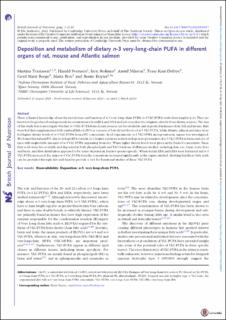Deposition and metabolism of dietary n-3 very-long-chain PUFA in different organs of rat, mouse and Atlantic salmon
Torrissen, Martina; Svensen, Harald; Stoknes, Iren; Nilsson, Astrid; Østbye, Tone-Kari K; Berge, Gerd Marit; Bou, Marta; Ruyter, Bente
Peer reviewed, Journal article
Published version
Permanent lenke
https://hdl.handle.net/11250/2739160Utgivelsesdato
2021Metadata
Vis full innførselSamlinger
Sammendrag
There is limited knowledge about the metabolism and function of n-3 very-long-chain PUFA (n-3 VLC-PUFA) with chain lengths ≥ 24. They are known to be produced endogenously in certain tissues from EPA and DHA and not considered to originate directly from dietary sources. The aim of this study was to investigate whether n-3 VLC-PUFA from dietary sources are bio-available and deposited in tissues of rat, fish and mouse. Rats were fed diets supplemented with a natural fish oil (FO) as a source of low dietary levels of n-3 VLC-PUFA, while Atlantic salmon and mice were fed higher dietary levels of n-3 VLC-PUFA from a FO concentrate. In all experiments, n-3 VLC-PUFA incorporation in organs was investigated. We found that natural FO, due to its high EPA content, to a limited extent increased endogenous production of n-3 VLC-PUFA in brain and eye of mice with neglectable amounts of n-3 VLC-PUFA originating from diet. When higher dietary levels were given in the form of concentrate, these fatty acids were bio-available and deposited in both phospholipids and TAG fractions of all tissues studied, including skin, eye, brain, testis, liver and heart, and their distribution appeared to be tissue-dependent, but not species-specific. When dietary EPA and DHA were balanced and n-3 VLC-PUFA increased, the major n-3 VLC-PUFA from the concentrate increased significantly in the organs studied, showing that these fatty acids can be provided through diet and thereby provide a tool for functional studies of these VLC-PUFA.
